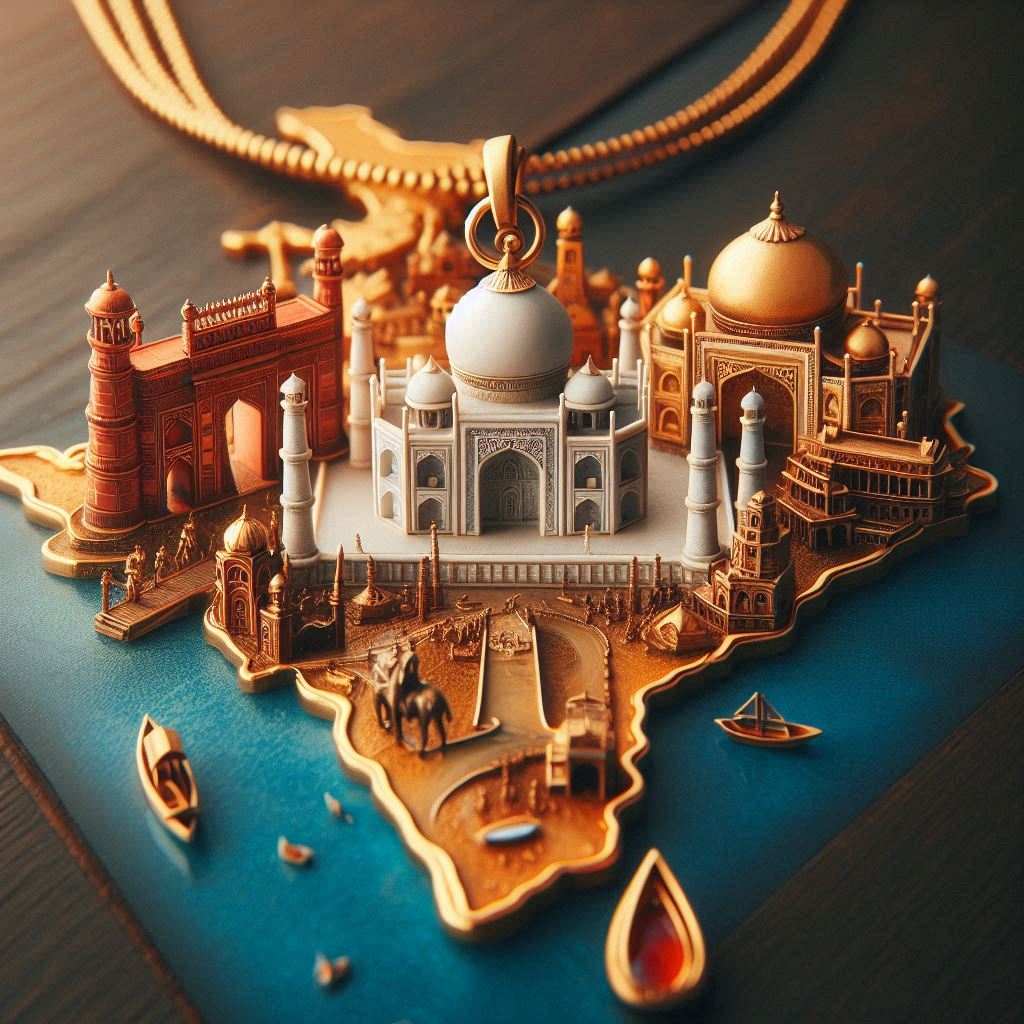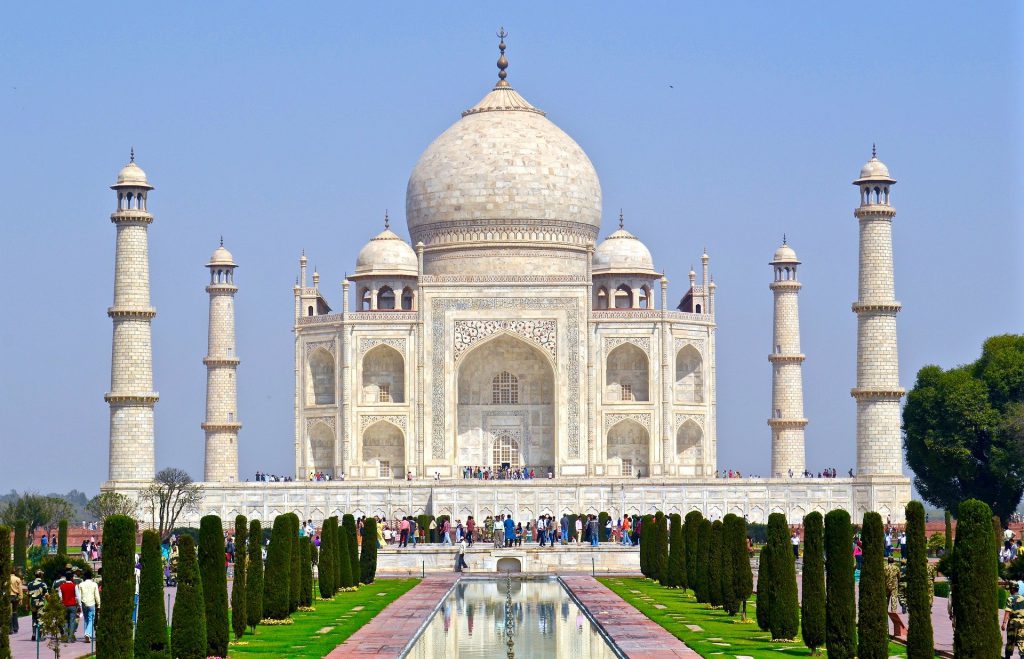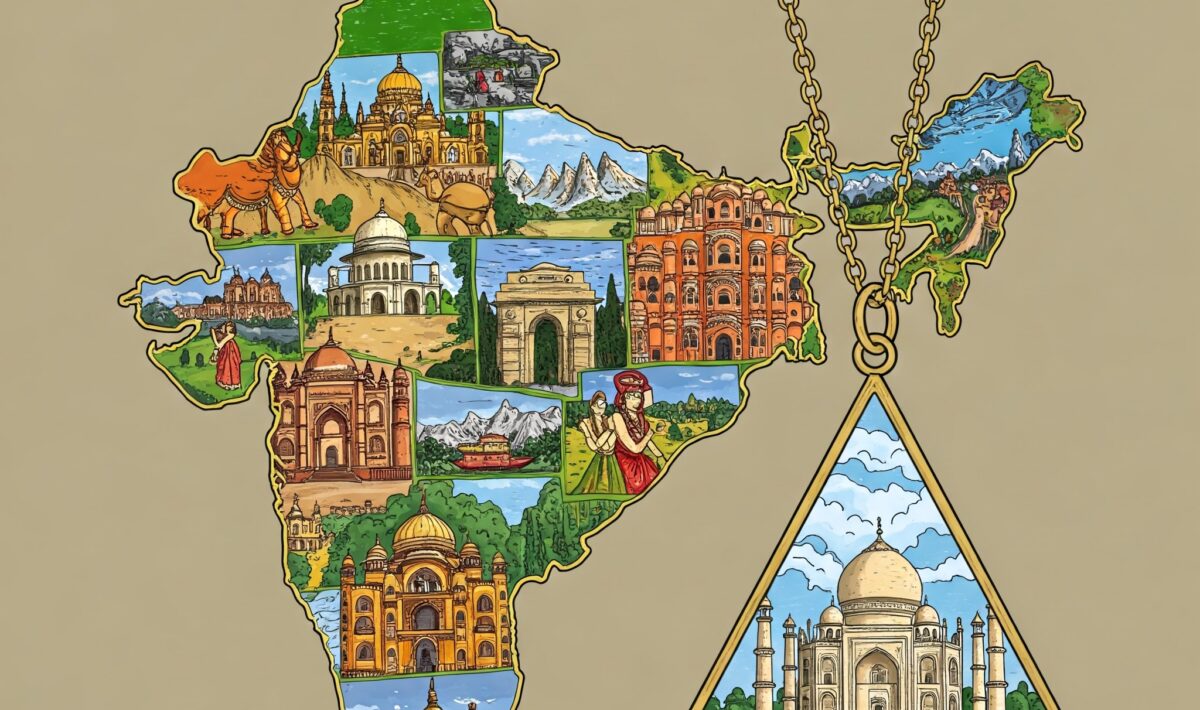Overview
The Golden Triangle is India’s most popular tourist circuit and an excellent introduction for first-time visitors. It connects Delhi, the nation’s capital; Agra, home of the Taj Mahal; and Jaipur, the capital of Rajasthan known as the “Pink City.” The three cities form a rough triangle about 200–250 km apart . A typical Golden Triangle trip takes about one week (often 5–7 days) , giving time to explore major attractions in each city. Many travelers begin and end in Delhi (a common international flight hub).

Highlights
In Delhi, visitors experience a mix of old and new – from Mughal monuments like the Red Fort and Jama Masjid to British colonial buildings and bustling bazaars . Agra’s crown jewel is the Taj Mahal, often visited at sunrise for the best light. Agra also features the impressive Agra Fort and nearby abandoned city of Fatehpur Sikri. Jaipur offers the Amber Fort, the Hawa Mahal (Palace of Winds), City Palace, and the Jantar Mantar observatory, all showcasing Rajasthan’s royal heritage. Travelers get a taste of three different states (Delhi is its own territory, Uttar Pradesh for Agra, and Rajasthan for Jaipur) .
Travel between locations
The circuit is well-connected by road and rail. Many tourists hire a private car+driver for flexibility and comfort – driving times are ~4 hours Delhi– Agra (233 km) and ~4–5 hours Agra–Jaipur (240 km) . A popular option is taking the train from Delhi to Agra (the high-speed Gatimaan Express or Shatabdi Express take ~2 hours) , then driving from Agra to Jaipur with sightseeing stops en route. Notably, between Agra and Jaipur you can stop at Fatehpur Sikri and the Abhaneri stepwell to break up the trip . Trains and highways are plentiful; advanced booking for trains is recommended, but tickets are affordable (around $10–$15 in AC chair class) . Within each city, you can use taxis, rideshare apps, or guided tours. Delhi’s metro is also a convenient way to get around the capital’s sights.
Here is the information about Vande Bharath and similar trains availability.
Delhi to Agra:
- Fastest travel time is around 1 hour 36 minutes to 1 hour 41 minutes.
- Example departure: Leaves Hazrat Nizamuddin at 14:40 and arrives at Agra Cantt at 16:16.
- Trains typically run daily, with both morning and afternoon departures.
Agra to Jaipur:
- Fastest trains take about 3 hours 50 minutes, while regular express trains can take up to almost 6 hours.
- The first train usually departs Agra Cantt around 6:00 AM. The fastest service departs in the evening.
- There is currently no dedicated Vande Bharat train on this route; the quickest options are Superfast Express trains.
Delhi to Jaipur:
- Fastest journey is about 3 hours 30 to 37 minutes.
- Example: One train departs Delhi Cantt at 18:28 and arrives in Jaipur at 22:05, operating all days except Wednesday.
- Other quick trains, such as the Shatabdi and Rajdhani, complete the journey in 4 to 4.5 hours.
Current Schedule Notes:
- Delhi–Agra operates with stable daily schedules and several time options.
- Delhi–Jaipur has a dedicated service, with departures most evenings from Delhi Cantt, running 6 days a week except Wednesdays.
- Agra–Jaipur currently uses Superfast Express trains instead of a dedicated Vande Bharat service.

Seasonal considerations
When to go?
October to March is ideal, with pleasant weather (daytime ~20–30°C) and minimal rain. This is peak tourist season so expect big crowds at popular sites. April to June brings intense heat in the plains (Delhi/Agra often 40°C+), which can be exhausting for sightseeing – many avoid these months or tour early in the day.
The monsoon (July–September) sees heavy rain especially in Delhi and Agra; while the heat eases, rain can occasionally disrupt plans. That said, there is no truly bad time – even monsoon has its charms and the sites remain open , but most travelers prefer the cooler, drier winter period. Pack a light jacket for December– January nights in North India when temperatures can drop below 10°C, especially in Delhi .
Pros & Cons:
This route’s biggest advantage is covering India’s most famous landmarks in a short time. It’s a convenient, well-trodden path with robust tourist services (hotels, guides, transport). The cultural immersion is significant – from the chaos of Old Delhi’s streets to the grandeur of Rajput forts. However, the popularity means one should be prepared for crowds, touts, and tourist pricing in places. It’s a “classic” tour – great for first timers, though some experienced travelers find it too mainstream or fast-paced. As one travel writer noted, the Golden Triangle is heavily touristed but still worthwhile – “can you imagine traveling to India and not seeing the Taj Mahal?” . The key is to plan well to avoid rush (e.g. visit major sites early) and maybe include one off-beat stop (such as Abhaneri stepwell or a village hotel as some tours do) for balance.
Holiday closures & adjustments
A crucial planning point – the Taj Mahal is closed every Friday for general viewing. If your Agra day falls on a Friday, you’ll need to rearrange – for example, visit Agra Fort and Fatehpur Sikri that day, and see the Taj early Saturday instead. Most other monuments on this route are open daily, though some, like Delhi’s museums or Akshardham Temple, close Mondays. Always double-check the schedule for each site. The Taj Mahal also offers limited night viewing on full moon nights except Fridays – an option if timed right (tickets are limited). You can check these dates through India Fest app by Travebrate.
Typical costs
The Golden Triangle can fit any budget. As a backpacker, one can do it for under $30 (₹2,500) per day by using trains/buses, budget guesthouses, and local eateries . Mid-range guided tours or private car with 3-star hotels might run around $75– $100 per day per person (around ₹6,000–₹8,000) including transport and decent accommodations. Luxury travelers have options like 5-star heritage hotels and business-class trains – budgets can be $200+ per day in that case. Entrance fees for foreigners at major monuments are higher than for Indians (e.g. Taj Mahal ₹1,100 ~$14), but still reasonable. Overall, a one-week Golden Triangle trip typically costs $500– $1000 per person for a comfortable experience, excluding international airfare. Package tours for 1 week (including a driver, guides, hotels) often range from $700 up to $2,000 depending on hotel category. Tipping is customary for drivers and guides. Haggling can save money in markets, and using apps like Uber in cities keeps local transport costs predictable.
Guide services
All three cities have ample government-licensed guides available. It’s easy to hire local tour guides at monuments – for example, the Archaeological Survey of India (ASI) offers official guides at the Taj Mahal and Agra Fort (look for those with ID badges). Delhi, Agra, and Jaipur each have many licensed guides trained by the Ministry of Tourism. Hiring a guide (fees can range ₹1,500–3,000/day or negotiable per site) is great for historical insights and navigating smoothly. Moreover, each city has a Government of India tourist office where you can get information or arrange tours with approved guides. Bottom line: The Golden Triangle is a must-do itinerary for many visitors, offering a rich slice of India’s history and culture in a manageable loop . With smart planning around seasons and site closures, it’s immensely rewarding.
Typical 7 days itinerary for Golden Triangle
This itinerary is fast-paced to cover the highlights. Remember, as a Travebrate plan, it’s fully customizable to your interests and pace!
Part 1: The Imperial Capital – Delhi (2 Days)
Day 1: Arrival and Echoes of Modern History
- Morning (10:00 AM – 1:00 PM): Arrive in Delhi, check into your hotel, and freshen up. For your first taste of the city, we’ll start with the elegant history of South Delhi. Head to Qutub Minar, a towering UNESCO World Heritage site. The intricate carvings and the surrounding archaeological park are a fantastic introduction to Indo-Islamic architecture.
- Afternoon (2:00 PM – 5:00 PM): After lunch, visit Humayun’s Tomb. This magnificent garden-tomb was the architectural inspiration for the Taj Mahal and is a serene, beautiful place to explore. Following this, make a brief stop at the Lotus Temple, an architectural marvel of modern India (best for photos from the outside to save time).
- Evening (6:00 PM onwards): Drive to the heart of New Delhi. See India Gate as it’s lit up and surrounded by locals enjoying the evening. Enjoy dinner at a restaurant in the historic Connaught Place or the trendy Hauz Khas Village.
Day 2: The Soul of Old Delhi & Grandeur of New Delhi
- Morning (9:00 AM – 1:00 PM): Dive into the vibrant chaos of Old Delhi. We recommend hiring a cycle-rickshaw for this part. Visit the majestic Jama Masjid, India’s largest mosque. Afterwards, ride through the narrow lanes of Chandni Chowk, experiencing the sights, sounds, and smells of its ancient markets, including the famous spice market (Khari Baoli).
- Afternoon (2:30 PM – 5:00 PM): Contrast the morning’s experience with the stately grandeur of Lutyens’ Delhi. Drive past the Rashtrapati Bhavan (President’s Residence) and the Parliament House. Then, find peace and a powerful sense of community at Gurudwara Bangla Sahib, a beautiful Sikh temple. Don’t miss seeing the massive community kitchen (langar) where thousands are fed for free daily.
- Evening: Enjoy a farewell dinner in Delhi before your journey to Agra tomorrow.
Part 2: The City of Eternal Love – Agra (2 Days)
Day 3: Journey to Agra & a Sunset Prelude
- Morning (8:00 AM – 12:00 PM): After breakfast, begin your journey to Agra. The drive via the Yamuna Expressway takes approximately 3-4 hours.
- Afternoon (1:00 PM – 4:00 PM): Check into your Agra hotel and have lunch. After resting, it’s time for a less-common, but breathtaking, first look at the Taj Mahal. Visit the Mehtab Bagh (Moonlight Garden), located directly across the Yamuna River.
- Evening (5:00 PM onwards): From Mehtab Bagh, you will witness a stunning sunset with the Taj Mahal in the foreground. It’s a photographer’s dream and a far more peaceful experience than the sunset crowd at the monument itself.
Day 4: The Taj Mahal at Sunrise & The Mighty Agra Fort
- Morning (5:30 AM – 9:00 AM): The main event. An early start is essential. Arrive at the Taj Mahal before sunrise to see the marble monument change colours with the first rays of light. This is the most magical time to experience its beauty. We recommend hiring a licensed guide to explain its history and stories.
- Late Morning (10:00 AM – 1:00 PM): After breakfast, visit the imposing Agra Fort, a UNESCO World Heritage site. This red sandstone fortress was the main residence of the Mughal emperors. Explore its palaces, audience halls, and get another beautiful view of the Taj Mahal from its ramparts.
- Afternoon (2:30 PM onwards): Visit the exquisite Tomb of Itimad-ud-Daulah, often called the “Baby Taj” or the “Jewel Box”. It’s a beautiful, intricate tomb that predates the Taj Mahal and is far less crowded.
Part 3: The Pink City – Jaipur (2 Days)
Day 5: The Ghost City & Arrival in Jaipur
- Morning (8:30 AM – 1:00 PM): After breakfast, begin your drive to Jaipur (approx. 4-5 hours). En route, we will stop at a forgotten marvel: Fatehpur Sikri. This deserted red sandstone city was the capital of the Mughal Empire for a brief period and is a perfectly preserved example of Mughal architecture.
- Afternoon (2:00 PM – 5:00 PM): Continue your drive to Jaipur.
- Evening (5:00 PM onwards): Check into your Jaipur hotel. For dinner, consider a rooftop restaurant with views of the illuminated city or immerse yourself in Rajasthani culture at a village-themed resort like Chokhi Dhani.
Day 6: Forts, Palaces, and Pink Hues
- Morning (8:30 AM – 1:00 PM): Today is about the magnificent forts of Jaipur. Start with the majestic Amer Fort (Amber Fort). We recommend taking a jeep up the ramparts to save time and energy. Explore its sprawling complex of courtyards and halls.
- Afternoon (2:00 PM – 5:30 PM): After lunch, visit the City Palace, which is still home to the former royal family. The complex is a beautiful blend of Rajasthani and Mughal architecture. Next to it is Jantar Mantar, the fascinating royal observatory with its giant, 18th-century astronomical instruments. End with a photo stop at the iconic Hawa Mahal (Palace of Winds). Travebrate Tip: The best photos are taken from the cafes across the road.
- Evening: Explore the bustling local markets like Johari Bazaar (for jewelry) or Bapu Bazaar (for textiles and handicrafts).
Day 7: Farewell Rajasthan & Departure
- Morning: Enjoy a final Rajasthani breakfast. Depending on your flight schedule, you could visit the Albert Hall Museum or do some last-minute souvenir shopping.
- Afternoon: Depart from Jaipur. You can either:
- Fly out from Jaipur International Airport (JAI). This is the most convenient option.
- Drive back to Delhi (approx. 5-6 hours) to catch your flight from Indira Gandhi International Airport (DEL). Please allow ample time for this drive.
Planning Your Own Golden Triangle Trip? Let Us Perfect It.
Feeling inspired to explore Delhi, Agra, and Jaipur, but overwhelmed by the logistics? You’re not alone. Planning a trip that truly captures the magic of the Golden Triangle, while avoiding the pitfalls, is a huge task.
That’s where Travebrate comes in.
We are a specialist travel planning service designed for independent travelers like you. We believe you should have the freedom to travel on your own, at your own pace, without being tied to a group tour. We just handle the stressful part for you – the planning.
When you opt for a Travebrate plan, here’s what you get:
- A Flawless Itinerary: We craft a day-by-day plan that is optimized for you. We track everything from the best time of day to visit the Taj Mahal to which attractions are closed for local holidays, ensuring you never waste a moment.
- Discover More: Our plans go beyond the highlights. We can include fascinating nearby attractions that most tourists miss, giving you a richer, more authentic experience.
- Unforgettable Experiences: Dream of a hot air balloon ride over Jaipur’s forts at sunrise? Or want to know the best spots for night viewing of monuments? We build these special moments right into your schedule.
- Unbiased Suggestions: Our recommendations for restaurants, cafes, and local activities are 100% unbiased. We don’t accept commissions, so our only goal is to suggest what’s genuinely the best, not what pays us.
Please Note: To give you complete control over your budget and style, we do not book your hotels or flights. We provide the expert blueprint; you book the components you’re most comfortable with.
Ready for a seamless, stress-free, and unforgettable Golden Triangle adventure?
Reach out to us for India Itinerary.


